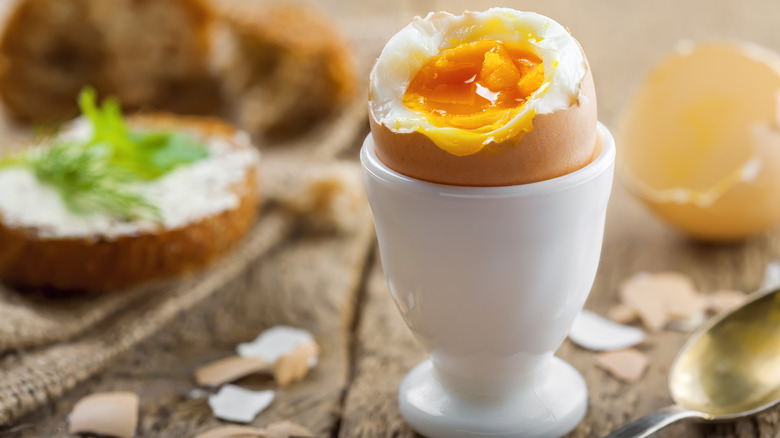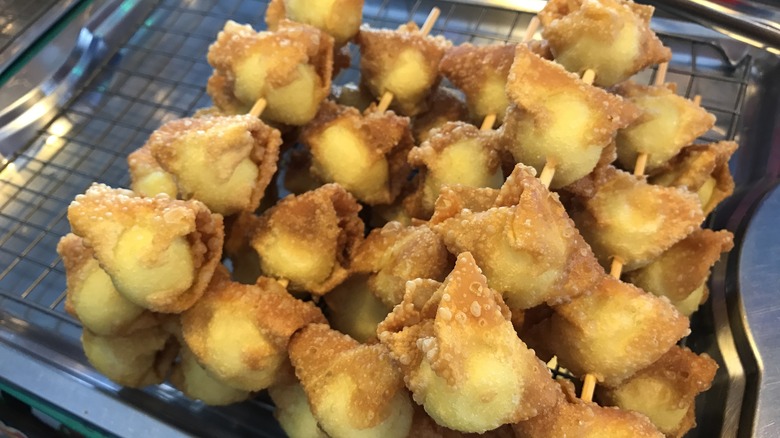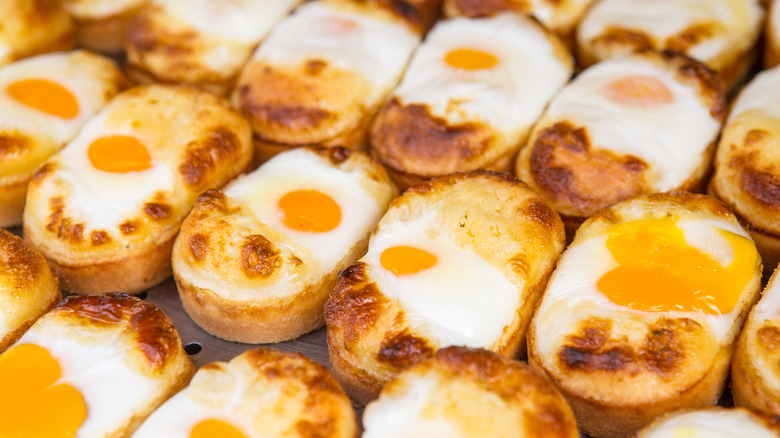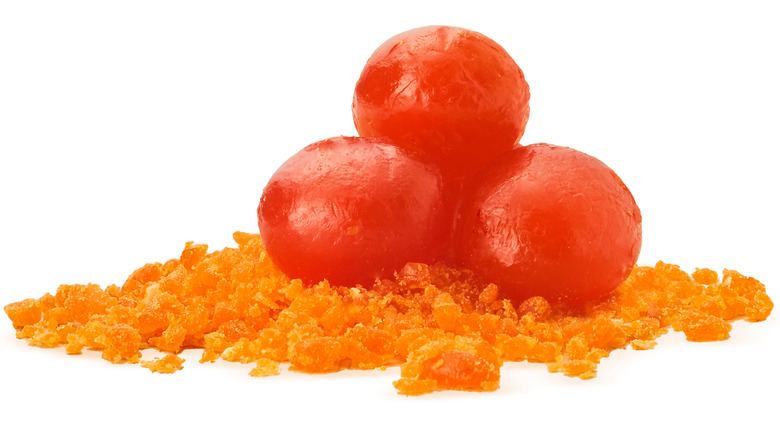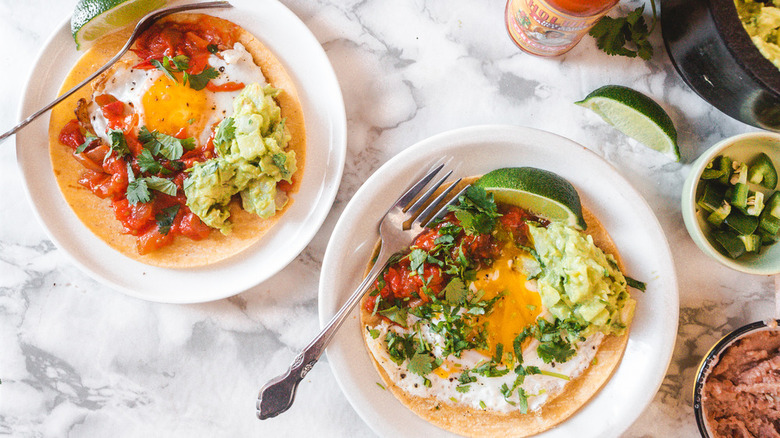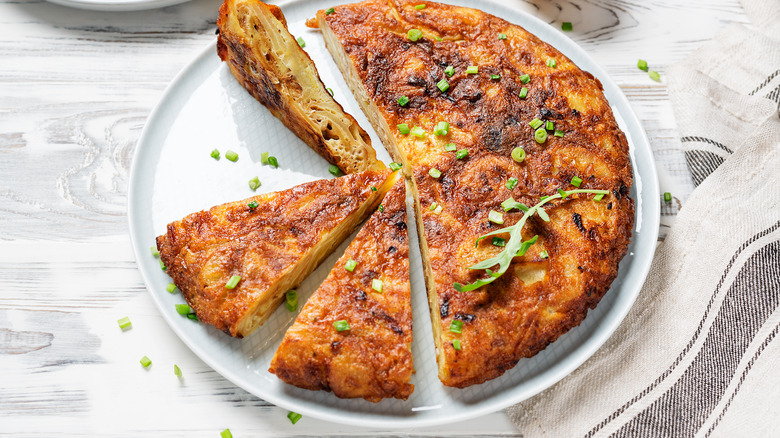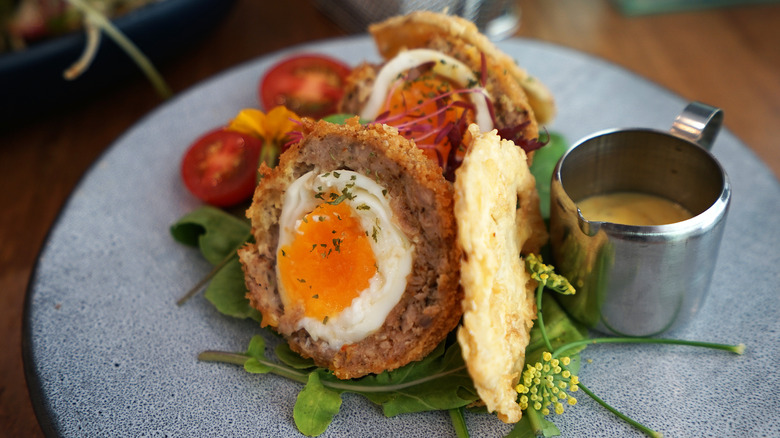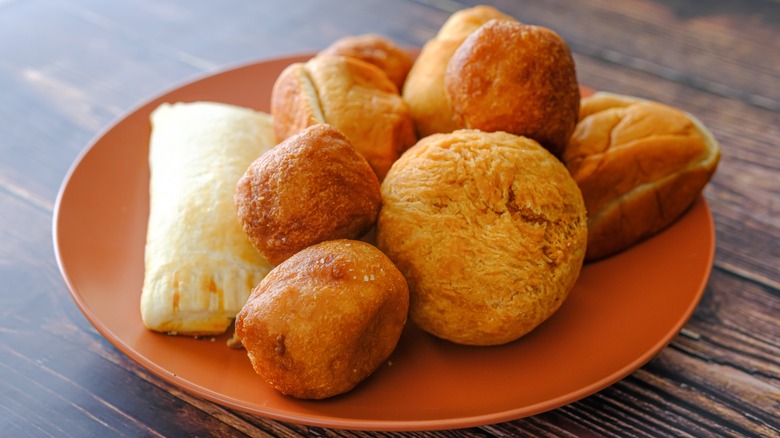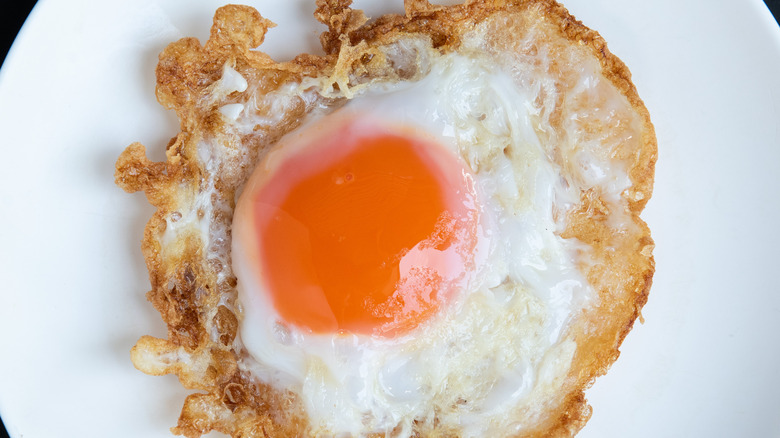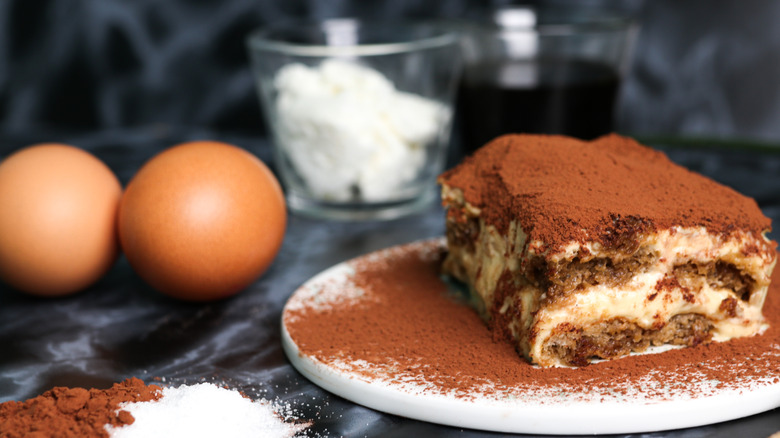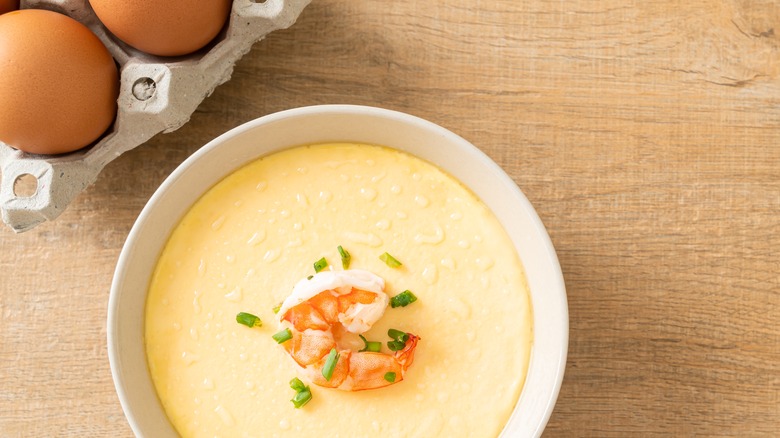13 International Egg Hacks To Welcome Into Your Kitchen
There's nothing quite as versatile as an egg. You can cook it so many ways for breakfast, brunch, lunch, and dinner as well as snack-time and suppertime. Eggs are not only nutritious but they're also tasty, easy to turn into a meal, and affordable. If you're a fan, then check out our amazing egg hacks. With so many different ways of cooking with eggs, it's no surprise that there're plenty of tips to add to the mix.
Whether the star attraction or added to a recipe, eggs are beloved the world over. Cooks in different countries all put their own unique spins on the art of egg cookery. If you're feeling adventurous and love cuisine from across the globe, then grab a carton of eggs. Now you can discover 13 international egg hacks to welcome into your kitchen from Asian steamed eggs to how to make a soft-yolk Scotch egg. Roll out the culinary map and learn about different techniques and dishes along the way.
1. Boil an egg like British chef Delia Smith
Renowned British TV chef Delia Smith put out a series of "How To Cook" books in the late '90s to take home cooks back to basics. One of the recipes featured was a guide on how to soft-boil an egg. It's not as strange as it sounds — often it's the simplest of dishes that can be easy to learn but a challenge to master. How many times have you boiled an egg only to crack open the shell to reveal a hard yolk or a watery white that's underdone? If you've ever eaten breakfast at a hotel you'll know that even trained chefs often don't get the consistency just right for a perfectly cooked soft-boiled egg.
To follow Delia's method add eggs to a softly simmering small pan of boiling water for a minute. Take the pan off the heat, put the lid on, and leave the eggs for 6 minutes. What's also important is that the eggs you use are not too cold and that the saucepan isn't too big. This is so that they don't crack while they're cooking. Another good tip to prevent cracking is to pierce the wider end of the egg beforehand. Always submerge the eggs fully in water and use a timer. If you don't want a soft yolk then try our hard-boiled eggs recipe.
2. Serve quail eggs for a Thai snack
Quail eggs are so cute and their small size makes them perfect for a snack. You can use them to create a Thai-style bite that's a classic street-food treat and is super easy to make. As well as quail eggs, you'll need wonton wrappers, wooden skewers, and a pan of hot oil.
Shell hard-boiled quail eggs and wrap each one in a wonton wrapper. Roll the egg and then fold the sides so that none of the egg is showing. Thread a few of these on a stick and deep fry them so that they're lovely and crispy on the outside and soft on the inside. Another snack that's popular in Thailand, and which you can easily make at home, is fried quail eggs. They're cooked in a special pan used to make little pancakes called khanom krok, but you can use an everyday pan. Serve with a sprinkle of pepper and a dash of hot sauce such as Thai Sriracha.
3. Make a Japanese onsen egg without a sous vide machine
An onsen is a Japanese hot spring, and once upon a time, this could have been a place where eggs were cooked. An onsen egg, otherwise known as a hot spring egg, certainly has its culinary roots in Japan's onsen-rich heritage. The egg is slow-cooked at a lower temperature than boiled eggs. With a soft-boiled egg, the yolk is runny and the white is not. With an onsen egg, the white and the yolk are both creamy and soft. Because of the specific temperature required, which is around 63 degrees Celcius, a sous vide machine is perfect for making eggs this way.
However, you can easily make them with a rice cooker according to No Recipes on YouTube. When you're making onsen eggs you want to use eggs that are cold so there's no need to take them out of the fridge beforehand. To get the best texture use super-fresh eggs too. In your rice cooker add 5 cups of boiling water. Cool this down with 1½ cups of room-temperature water. Add your eggs as you would for boiled eggs. Press the Keep Warm button on your rice cooker and cook them for around 25 minutes. The eggs are perfect as a topping on any Asian dish and they make any meal look high-end.
4. Swap a sandwich for Korean egg bread
Forget a simple egg sandwich, although this is delicious too. Forget eggy bread and French toast, although they're perfect for breakfast. Combine eggs with carbs Asian-style and make Korean egg bread, or gyeran bbang, which is a popular street snack. It's the perfect comfort food, especially when it's cold outside, but you can enjoy making this at home all year round. Egg bread is made by cooking a bread-style batter in individual servings each with an egg either on top or inside.
The bread is a little like a muffin or a fluffy pancake and has a sweet and savory taste. To make it at home, all you need is a greased muffin tin and some staple ingredients you're likely to have in your kitchen. Make a batter with flour, milk, and egg, and add some sugar and melted butter into the mixture too. Pour this into the muffin holders and crack an egg on top of each. Bake and check that the bread is done by piercing it with a fork or skewer. It should come out clean. In addition to making plain egg bread, you can add whatever extra goodies you like. Great pairings include cheese and bacon, and it's traditional to add tomato sauce too.
5. Scramble small curds to make a French omelet
There are so many different styles of omelets. In the U.S. omelets are firm and often golden brown. You could make our rice paper variety or a fluffy omurice dish from Japan. And there's also the dramatic-looking tornado omelet that originates from Korea. It's incredible how many things you can make with just an egg and a pan. If you love soft, barely cooked eggs that are velvety with a delicate taste and texture then you can't get better than a French omelet.
Renowned French chef Jacques Pépin has a great hack for making this French classic and reveals his top tips on the American Masters channel on YouTube. Get your pan nice and hot and add some butter. Whisk up 4 eggs and add some fresh herbs. Traditionally these are chives, tarragon, parsley, and chervil. Pour the eggs into the pan and vigorously stir. This results in small curds forming and once you've got a panful of curds, tip it so that the egg pools at one end. From the top, fold over the egg that's continuing to cook so it covers the runny curds. Use your wrist to bang the handle of the pan so that the bottom edge of the omelet pops up. Fold this side over so that it meets the other folded edge in the middle. Serve fold-side down.
6. Make and grate Chinese salted egg yolks
If you've yet to discover what all the fuss is about with salted egg yolks then you're in for a treat. Creamy and salty, with a candy-like texture, the salted egg yolk food trend has truly hit the U.S. after gaining even more fans in Asia where this umami food is everywhere. Salted egg flavor can be found in foods as varied as potato chips and even milkshakes. Recreating it at home isn't terribly difficult either, and you can make your own with some eggs and lots of salt.
All you need to do is pop egg yolks onto a layer of salt and completely cover them. You want them separated out and be careful not to break them. Leave them for a couple of days in the fridge and then brush off the salt and store them in the fridge once again. Another method is salting and leaving the yolks out of the fridge for 5-7 days and then dehydrating them. You can also make whole salted eggs by putting unshelled fresh eggs in white vinegar and then salt before covering them with plastic wrap and leaving for a month. Conde Naste Traveller reports how Taiwanese chef Andre Chiang enjoys salted egg yolk with baked sweet potatoes. Try grating the salted yolks over a big bowl of pasta in place of Parmesan. You could also try following Asian culinary tradition by using duck eggs instead of chicken eggs for a different consistency.
7. Poach eggs in salsa for huevos rancheros
Start your day the Mexican way with our traditional huevos rancheros. The taste of fried eggs on a soft tortilla with homemade salsa is a wake-up call to great food. Our method recommends frying the eggs and covering the pan with a lid to cook them. However, if you're not a fan of sunny-side-up eggs you can also scramble them instead. Make some guacamole and add that on top with a layer of refried beans underneath and some sour cream and cheese on top. If you grab some enchilada sauce you can turn this dish into a huevos rancheros casserole instead.
Another way to cook the eggs is in a tomato salsa-style sauce. As your sauce bubbles away on the stove, make a pit for each egg you want to add. Crack the eggs into these and let them cook away for around 5 minutes. The whites of the egg need to be set but you don't want the yolk to cook through. Drag parts of the white into the sauce more so that they cook quickly. That way your yolks won't be overcooked. There aren't any hard and fast rules with dishes like this and trial and error is sometimes the best way to perfect your own technique. You might prefer this simple dish without any frills or to elevate it with layers of flavor. Either way, the eggs are one of the main ingredients so you want to get these right.
8. Cook a cheat version of Spanish tortilla
There's no debate that eggs and potatoes go together incredibly well. You could make a plateful of fried eggs and fries to appreciate this taste combo. Or you could make a classic Spanish tortilla. If you're not familiar with this dish, then don't get it confused with a flour or corn tortilla that's used in Mexican cuisine. This tortilla is more like a thick omelet and inside are layers of cooked potato and onion. You need oodles of olive oil for this recipe which gives it a luxurious essence.
However, if frying potatoes sounds like too much hard work, or you just don't have any, then you could add potato chips instead. Just add the thin chips to the whisked-up egg and cook them at the same time. It's simple to make — probably the hardest step is flipping the tortilla. But even this is easy if you know how. All you need is a flat pan lid. Flip the half-cooked tortilla onto the lid, or you can use a plate. Turn the now-empty pan over the lid and slide the tortilla back into the pan so the uncooked side of the tortilla is now underneath ready to be cooked.
9. Create soft-boiled Scotch eggs
Scotch eggs are great for serving with other treats at a picnic or as a snack. Hard-boiled egg encased in sausage meat with a crispy coating creates layers of texture and flavors. If you want to leave out the meat, you can make our 3-ingredient Scotch eggs instead. With this recipe, you cover the eggs with falafel mix and bake in the oven.
If you love a boiled egg with a soft center then you might want to make soft-boiled Scotch eggs. The key to achieving this is to soft-boil your eggs as you usually would. Take them off the heat when they're still runny in the middle and plunge them into iced water. If you don't do this they'll continue to cook. Use the back of a spoon to crack the shells and then flip it around to peel off the broken bits. Don't put too much pressure on the egg or you'll break it. When you wrap the meat around the eggs you need to be gentle too. You can refrigerate the peeled eggs before adding the meat to make them less squishy. A good tip is to flatten the meat between parchment paper and then roll it around the egg. Using your fingers, pull off the excess meat from the sides so that you're not pressing on the soft egg. Cook how you like. They're great with a panko crust and deep-fried.
10. Stop African egg rolls from breaking
African egg rolls are a little like Scotch eggs except they're not made with meat. They're a popular streetside snack across Africa. The hard-boiled eggs are wrapped in dough with a little spice added. When you fry them the outside turns golden brown and crispy and when they cool down a little you can take a bite of these crunchy, yet fluffy orbs and taste the creaminess of the egg inside. You want the rolls to be smooth, but if you don't get the dough just right they can sometimes break apart in the hot oil.
It's All Food Africa offers some useful tips on YouTube to prevent problems with the dough. Firstly, make sure you don't use too much baking powder which will dry the dough out. Be wary of not adding too much butter either as this will react with the oil and make the dough greasy and less likely to be intact. Make sure the dough is nice and soft by not overworking it. Use floury hands to create the round shape once the egg is inside. Make sure the oil is hot enough that the rolls won't turn soggy but not too intense that they'll burn.
11. Cook Thai-style super crispy yet soft fried eggs
Do you love a runny yolk but at the same time don't like the white to be slippery? The contrast between a crispy egg white and a velvety soft yolk is incredible but this isn't the way eggs are served in the U.S. in general. However, in Thailand, fried eggs with super crispy whites are the norm. Omelets are often cooked so that they're really crunchy as well.
In a wok or deep pan add more oil than you usually would to fry an egg and get it nice and hot. You don't want to deep fry the egg but you want the whites to bubble up in the oil. If the yolk is off-center then gently move it back into position and then spoon hot oil over the top so that the yolk cooks too, but still stays soft. Fried eggs can be served with Thai basil chicken and rice.
12. Cook egg yolks gently for Italian tiramisu
To make our classic tiramisu you need to cook the egg yolks into a zabaglione. To do this, create a bain-marie with a heatproof bowl over a pan of boiling water. This enables you to make a fabulously custardy zabaglione. Once you've added rum and let the mixture cool down fold in mascarpone cream. It's this that gives this Italian dessert its creamy taste. Often, tiramisu recipes call for raw, pasteurized eggs. While these eggs have been treated to get rid of some bacteria, some health experts warn against eating even these eggs raw because of health risks (via Cleveland Clinic).
A great way to cool down the egg and sugar custard sauce is to keep stirring it once it's off the heat. Use a balloon whisk and keep it moving so that it cools down quickly. Whatever recipe you follow, the zabaglione has to be at room temperature before you can start adding other ingredients. Another method to cook the eggs without a double boiler is to add sugar syrup to them. Whisk your eggs in a food processor and at the same time melt sugar in water in a saucepan. When the sugar has dissolved and it's bubbling slowly pour this hot syrup into the eggs as they're still being whisked. Continue whisking as the eggy mixture cools.
13. Steam eggs the Asian way for a silky texture
If you like eggs then you've probably tried them cooked a variety of ways from fried to poached, scrambled, and boiled. But have you ever experienced the silky-smooth texture of steamed eggs? They're popular in Asia, but less so in the U.S., and yet they're so easy to make. If you've never tried eggs this way then give them a go and add this dish to your egg recipe repertoire. The secret is to get the measurements of water and eggs just right. Steamed eggs have the consistency of a custard and they should be firm but still wobble like jelly a little. Mix one part egg with two parts water, stir, and season. To get the smoothest possible texture, strain the mix into a bowl and then steam.
Another way to measure the water and egg amounts, according to Made With Lau, is to use ½ cup of water per egg. If you use warm water the eggs will be softer once they're steamed too. You can let the bowl you're cooking the eggs in sit in the boiling cooking water too. Just make sure it only comes up ⅓ of the side. Cover the bowl while you steam the eggs as this helps keep the texture velvety too. Once ready add whatever toppings you like such as pepper, green onions, and soy sauce. Or top with cooked shrimp.

